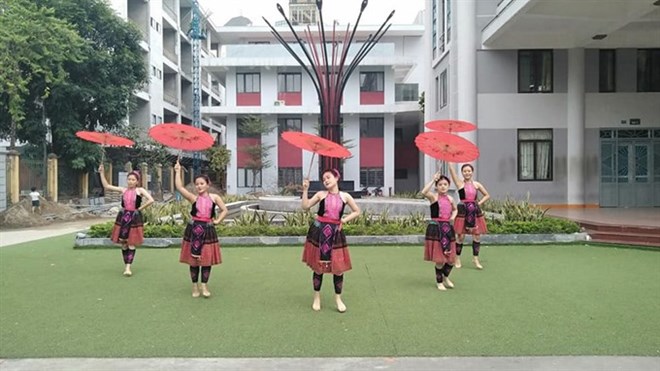
Hanoians will soon get a chance to experience ethnic Mong people’s traditional New Year dances and games.
The programme Xyoo Tshiab Nram Nroog (The Mong’s New Year Celebrated in the City) will take place on January 13 at the Hanoi University of Culture.

Young girls
of the Mong perform their traditional dance during the event. (Photo courtesy
of the organiser)
The annual event has been organised by the Action for Mong Development group
and partners to promote the unique culture of the Mong.
It also provides a chance for Mong people living far from home to enjoy their
traditional celebrations and to preserve their culture, according to Ma A Lau,
member of the organising board.
Various activities will take place including music performances, dancing, game
and a fair where goods and specialties of the Mong will be sold.
Participants will have a chance to try on traditional costumes of the Mong as
well as enjoy delicious food such as banh day (packed sticky rice with meat or
bean fillings wrapped in banana leaves) and men men (steamed minced maize).
A cultural space of the Mong will feature music from pan pipe, bamboo flute and
Jew’s harp.
Unlike the Lunar New Year of the Kinh majority which falls on the first day of
the first lunar month, the New Year’s Eve of the Mong falls on the first day of
the last lunar month. The celebration is to express gratitude to ancestors and
gods.
The Mong is one of the largest ethnic groups in Vietnam. They live mostly in
the mountainous regions in the northern provinces of Ha Giang, Lao Cai, Lai
Chau, Son La, and in the north-central and Central Highlands provinces of Thanh
Hoa, Nghe An, Gia Lai and Kon Tum.
There are various Mong groups, such as white Mong, black Mong and flower Mong.
Though they are different from the costumes and languages, the Mong nationwide
have some common cultural traits, such as their New Year celebration.
Source: VNA
Gongs hold a special place in the cultural and spiritual life of the Muong ethnic people in Hoa Binh province. More than musical instruments, they are an indispensable part of community rituals and collective memory, echoing through generations as a spiritual thread linking the past, present, and future.
Preserving and promoting the cultural values of the Muong ethnic group has become an urgent task in the current context, as many traditional values face the risk of fading away. This effort requires not only protecting the cultural identity but also eliminating outdated customs and developing a modern cultural lifestyle, contributing to sustainable values for the Muong community in Hoa Binh province.
The Muong ethnic culture, deeply rooted in Vietnam’s mountainous north, continues to be preserved and revitalised by dedicated individuals and communities determined to safeguard their ancestral identity.
The Muong group is one of the largest ethnic minorities in Vietnam, primarily found in Hoa Binh province. The Muong people in Hoa Binh boast a rich and diverse cultural treasure that reflects the unique identity of this ethnic group. Accounting for over 63% of the province's population, they have created and preserved numerous distinctive cultural values, contributing to their unique identity. Their cultural heritage is an invaluable asset, at the heart of their national identity, and represents a vibrant spiritual life that must be preserved and promoted in today’s modern world.
For generations, the ethnic communities of Hoa Binh province, particularly the Muong people, have preserved vibrant festivals deeply intertwined with the region’s geography, nature, and social traditions. These celebrations enrich Hoa Binh’s spiritual life and cultural identity, reflecting both folk beliefs and the intermingling of ethnic customs. Many of these festivals have endured the test of time, passed down through generations and continuing to thrive today. Among them, the Khai Ha (Going Down to the Field) festival stands out as one of the most significant events of the Muong ethnic group.
Muong calendar, known as sach doi, is an ancient folk knowledge system developed through observations of the movement of the pleiades star. This unique calendar consists of 12 bamboo sticks, each representing a lunar month. Specific days within each month are marked with distinct symbols, guiding locals in determining auspicious and inauspicious days for important activities.



